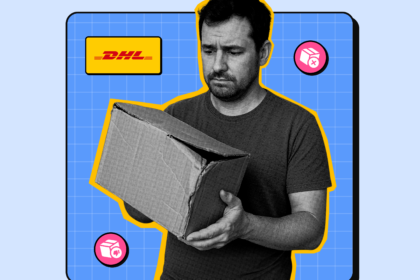How many times have you sent out a customer’s package and stayed eager to know their feedback, only to learn from them that it was damaged or didn’t make it to them at all?
Truly a haunting experience, given that all your efforts to convert the customer have now taken heavy ‘damage’, thanks to no fault of yours.
But if you think about the scale of these issues, you can clearly see that it is not something trivial. In fact, 7% to 11% of customers’ online orders arrive broken or damaged and close to 50% of Americans had claimed that at least one of their packages was lost.
Not just the scale. Even the intensity of lost and damaged packages is high for e-commerce merchants such as yourself.
So, how do you manage them and, better, reduce the risk of damage altogether? That’s exactly what we’ll answer in this article.
Why Packages Get Damaged in Transit
Shipping packages isn’t rocket science. You box up the products, label them, and send them off. But it is after a package leaves your hands that its risky journey truly begins. Believe us, a lot can go wrong between conveyor belts, cargo holds, and delivery trucks. Here’s why some of your packages might not make it to their destination in one piece:
1. Not Enough Cushioning Material
Fragile items are called ‘fragile’ for a reason. They can break. Easily. And so, just putting them in a plastic bag before tossing them into a box is a hard pass.
You need proper cushioning material like bubble wrap, packing peanuts, and air pillows to ensure if worst comes to worst, they can absorb impact from drops, vibrations, and even compression during transit. Why? No matter how reliable your carrier is, mishaps are bound to happen.
In fact, UPS and FedEx are known to drop packages from heights of up to 6 feet during normal handling. If your packaging isn’t solid enough, you will have to face some really angry customers.
2. Rough Handling
Between your warehouse and the customer’s address, your package changes hands multiple times. And not everyone will treat it like the delicate, precious cargo you’d hope for.
Look at it from the carrier’s POV. They operate in high-volume shipping environments where speed takes priority over caution. So, you can’t just slap a fragile sticker over the box and call it a day. You need proper internal padding and reinforced boxes to avoid damage. Double-boxing can also help reduce the risk of breakage.
3. Infestation Damage
A humid or poorly maintained warehouse offers the perfect breeding place for rodents and insects. These pests can easily infiltrate packaging, making a delicious snack of your packages. As a result, you not only have to deal with unhappy customers but also financial loss.
This risk is a huge concern for specific products like food, textiles, and paper goods. Therefore, it’s important to use pest-resistant packaging, like reinforced plastic wraps and airtight containers, to keep these pesky pests at bay.
4. Perishable Items
Have you ever seen a movie where the protagonist is racing against time to diffuse a bomb? If they’re successful, they save thousands of lives. If not? Well, you know how that ends.
Why are we talking about time bombs here? Because shipping perishable goods can feel the same. You’re fighting against the clock (and the weather) to ensure it reaches its destination safely. Without proper temperature control, items like food, pharmaceuticals, or flowers can spoil before they even arrive.
To avoid this, you need efficient cold chain logistics like insulated packaging, gel packs, and dry ice to extend shelf life.
5. Wrong Package Size
Packing a tiny mirror into an oversized box isn’t just wasteful—it’s risky. If there’s too much empty space, the item shifts around, increasing the chance of breakage. On the flip side, if you use a box that’s too small, you risk crushing it under pressure.
So, how do you find the sweet spot? Following the ‘two-inch rule’ can be a safe bet. It involves leaving about two inches of padding between the product and the box walls to absorb shock in case of drops or rough handling.
Preventing Package Damage
Shipping damage can not only erode customer trust but can also eat into your profits. Therefore, the best way to manage them is to do your best to avoid them in the first place. Here are some preventative strategies you can consider:
1. Choose the Right Box Size
Your packaging needs to be snug, not oversized or suffocating. If the box is too big, the item rattles around and risks getting damaged. On the flip side, squeezing something into a box that is too small puts unnecessary pressure on it.
So, select a box that’s just the right size for your item, leaving enough room for cushioning. If your product moves when you shake the box, you need to either resize the box or add more protective material.
2. Use Sturdy Packaging
Thin, flimsy cardboard might be fine for lightweight items, but if you’re shipping something fragile or valuable, you’ll need a double-walled, sturdy box that can handle a few bumps along the way.
Investing in a durable shipping box might cost a little more upfront, but it’s way cheaper than replacing damaged goods.
3. Fill Empty Spaces
Even if you have the right box, leaving gaps inside can be a mistake. As a rule of thumb, the less your item moves, the safer it is. So, use materials like bubble wrap, foam inserts, air pillows, or crumpled kraft paper to fill any empty spaces.
4. Label Fragile Items
Writing “FRAGILE” on a package isn’t a magical solution. While it can encourage careful handling, it won’t stop a rushed delivery worker from tossing the box onto a truck. So, what should you do? Combine clear labeling with smart packaging. Along with a “FRAGILE” sticker, use labels like:
- ‘This Side Up’ to prevent the box from being flipped
- ‘Do Not Stack’ to reduce the risk of getting crushed under heavy packages
5. Invest in Shipping Insurance
Accidents can happen despite the best packaging. That’s where shipping insurance comes in. It ensures you’re covered if something goes wrong. With LateShipment.com’s shipment protection, you get:
- Comprehensive Shipment Protection: Covers loss, damage, and missing items
- Intelligent Insurance Automation: Insures shipments automatically so you don’t have to
- Automated Claims Management: Saves you hours of back-and-forth with carriers
- Risk Intelligence: Optimizes operations and risk management so you can plan better
Impact of Damaged Packages on Businesses
To understand the seriousness of packages getting lost and damaged, put yourself in the shoes of your customers. They’ve anticipated long enough to collect their order, only to discover that it’s arrived broken or is missing.
While this is frustrating enough, the situation can turn out to be worse if their purchase is a gift for their loved ones. Such instances can instantly escalate things and infuriate your customers, who might make hasty decisions that can prove to be costly for you.
The first action a frustrated customer would take in such situations is simply choosing to quit shopping with you as a result of the bad experience they faced. This, in turn, can lead to unnecessary costs for your business in the form of:
Low customer retention rate (CRR)
Your retention rate is a metric that shows whether your customers are happy doing business with you to the extent of staying as your customer for an extended period. A good retention rate means profiting from repeat shopping, while a low rate is the harsh truth of losing money to customer churn.
Low customer lifetime value (CLV)
An extension of the retention rate is the customer’s lifetime value. It is the total amount of money a customer is expected to spend with you during the span of your relationship. When package delivery issues lead to customers dropping out, your CLV can become low or negative, implying that you are spending more on a customer than what you’re getting back from them.
Increased damage to brand reputation
A customer who has decided to end ties with you might not always go unannounced. In most cases, they take their frustrations to social media and tarnish your brand’s online reputation, leading their friends and followers (who can be your potential customers) to avoid your business. On a related note, there are definitive ways to deal with such customer rants that you can follow to mitigate their angst as well as paint a positive picture for others.
Increased costs from order returns and cancellations
When a customer’s order is lost or damaged, it is absolutely fair that they expect you to refund them. But such returns and cancellations, which happen due to your own fault, can lead to severe costs that can lower your profit margin.
Increased acquisition costs (CAC)
The last nail in this coffin is your pining over your efforts to convert the customer after they’ve simply dropped off. While you may briefly consider simply replacing one customer with another, keep in mind that acquiring customers is more expensive than retaining a customer.
It is natural to wonder why you have to stand to lose so much, especially when such issues happen outside your control and cannot be directly linked to you. Know that each purchase made by your customer is for your brand and not for your shipping partner, who works in the background. This puts the onus on you to take care of their deliveries, which plays a vital part in the overall customer experience. Thus, you are inclined to take actions that can avoid all of the aforementioned problems.
What to Do When a Package Arrives Damaged
You don’t have to panic the instant the customer comes forward with a complaint of their package being broken, missing, or lost in transit. There are several approaches that you can take to mitigate their frustrations and attempt to change their bad delivery experience into a positive one.
1. Have an empathetic approach
As we mentioned before, these customers who may sound angry have been robbed of the opportunity to be delighted while opening their package. So, it is understandable that they are frustrated and want you, the retailer, to handle the situation before it gets worse.
In such cases, the first step is to always deal with the situation empathetically. Acknowledge the incident and apologize for it (despite there being no fault of yours).
Trust me, they don’t enjoy seeing you pointing your hands at the shipping carrier for delivery issues of any kind. Take ownership of the incident and assure them that things will be resolved at the earliest.
Personalize your conversations in such a way that your customers know that they’re being treated as important and not just as random, faceless customers.
2. Ask the customer how they would like to get the issue resolved
Assuming what the customer wants might not be the best plan of action at all times. Especially when the customers expect you to listen to their concerns actively.
In such cases, it is best to resolve the issue based on your customers’ requirements. Don’t hesitate to ask your customers how they would like you to rectify things.
Some customers who have still not been able to come out of the bad experience might settle for a refund on their purchase, while customers who badly want the product would like to replace their order.
The best ploy is to provide multiple options and let your customers choose what’s best for them. This way, your customers feel in control of their decisions and gain increased confidence while shopping with you.
3. Send out replacement packages via expedited shipping
A customer who is initiating a replacement for their damaged or lost product is someone who is given a second chance to set things right. Thus, if a customer wants a replacement instead of a return, make sure you put maximum effort into converting their angst into delight.
You can do the same by offering a free return on the damaged product and sending out a replacement via an expedited shipping option out of your own pockets.
This way, you have a great opportunity to reverse the bad delivery experience and set customers on the path toward satisfaction.
4. Recover costs via shipping insurance and refunds
Focus on improving your customers’ delivery experience and leaving out the costs associated with them. Don’t worry about these out-of-pocket costs each time there’s a delivery issue; there are ways for you to save on them.
One way is to insure your packages, especially the high-value ones, with your shipping carriers or a third-party service provider to recover any unfortunate losses on a parcel that you shipped. To get the best out of shipping insurance, you need to get your hands dirty with all the relevant information, such as product qualification, documentation required, rate comparison, etc.
The other way is to start claiming shipping refunds from your carriers for each delivery failure on their behalf. If you’ve not waived your rights to claim refunds, know that not only delays, lost and damaged packages, but also over 50 carrier errors might be entitled to refunds.
Also, manually filing claims can be a tiresome task. Instead, you can make use of an automated parcel audit solution that takes care of auditing your shipping invoices and filing claims while saving you time, effort, and, most importantly, money.
BONUS: The damage is done, but is the package really lost?
Damages to the package are visible. Either on the cover or on the inside, making it clear of an incident. But the case isn’t the same with lost packages.
There are instances where packages turn up after being rerouted somewhere, or the issue at hand might be due to either a wrong address or a weather-related one. Quite simply, it is not unheard of for a package to turn up a day or two late.
With customer disappointment inevitable in either case, there is a remote chance that their frustrations can be mitigated when the delivery arrives a couple of days late rather than getting lost. In such cases, you need to take a different approach and treat the incident as a late delivery.
There can also be instances where the package goes missing after getting delivered. In such cases, the issue needs to be treated as a stolen package incident.
Following these steps can definitely help you take control of the situation and handle it all. However, all of these are effective only when the issues have occurred. By that time, it becomes a bit late to work on your CX efforts, given that your customers are now frustrated.
But what if there was a way to resolve such issues even before they’ve impacted the customer?
This is where you start taking a proactive approach to things rather than being reactive to not just damaged packages but all the delivery issues.
How Businesses Can Minimize Package Damage
Even with the best packaging and shipping practices, some things are simply out of your control. Packages get dropped, mishandled, or stuck in transit, leaving you struggling to fix the issue after the damage has already been done. But what if you could step in before a frustrated customer reaches out?
With a post-purchase automation platform like LateShipment.com, you can track parcels in real time and gain the ability to proactively step in to resolve issues when things seem like they are going wrong.
For example, with a complete view of your parcels in transit, you can:
- Stay aware of packages that are damaged at the loading or sorting facility (when it is about to be sent out for delivery).
- Set up alerts for specific parcels that seem to be facing an issue like lagging behind schedule or getting misrouted from the intended destination.
Once you have gained these insights, you can instantly get in touch with the carrier to resolve the issue or send a quick replacement in case of a time-sensitive delivery.
Even if you’re unable to resolve the issue completely, communicating the issue to your customer (and not the other way around) via automated and personalized notifications helps mitigate their anxiety, gives them the confidence that you’d resolve the issue, and ultimately revive customers’ trust in your brand.
Not just providing a great delivery experience, LateShipment.com also helps you go all out with our post-purchase excellence cloud. Provide stellar delivery experiences with easy, seamless returns – all while significantly reducing your shipping spend by auditing your invoices and recovering eligible refunds for late deliveries, lost and damaged packages, and much more from your carriers.
Customer Support and Communication
Nothing spoils a shopping experience faster than receiving a damaged package. By the time a customer reaches out to you, they’re already frustrated. And the last thing they want is a long wait time, complicated return policies, or canned responses that make them feel unheard.
So, you need to go beyond generic help and show true empathy. Instead of ‘We’re sorry for the inconvenience,’ provide a more thoughtful response like ‘We understand how disappointing this must be, and we’re here to make it right for you.’ This will instantly reassure them that they’re not just another ticket in the queue.
And don’t stop at that. Offer a hassle-free resolution and make refunds or replacements as seamless as possible. Plus, if the damage is clear from tracking updates, why wait for the customer to report it? Proactively reaching out to them with a solution will not only save them the trouble but also strengthen their trust in your brand.
Conclusion
At the end of the day, you need to accept that damaged packages are inevitable. But losing customers because of them doesn’t have to be. Taking a proactive approach with packaging, shipping, and customer communication can help you minimize damage, reduce friction in resolutions, and turn a negative experience into a positive one.
But damage control shouldn’t mean profit loss.
That’s where LateShipment.com comes in. As the only cloud-based post-purchase excellence platform, LateShipment.com helps you recover lost revenue by automating shipping refunds and lost/damaged claims management.
The platform’s AI-powered invoice audits scan for over 50 service failures, ensuring you get back every dollar owed for late deliveries, billing errors, and damaged parcels. Plus, with automated claims processing and expert redressal, you can focus on delivering top-tier customer experiences while we handle the refunds.
Sign up for LateShipment.com today and say goodbye to the hassle of shipping damages.







